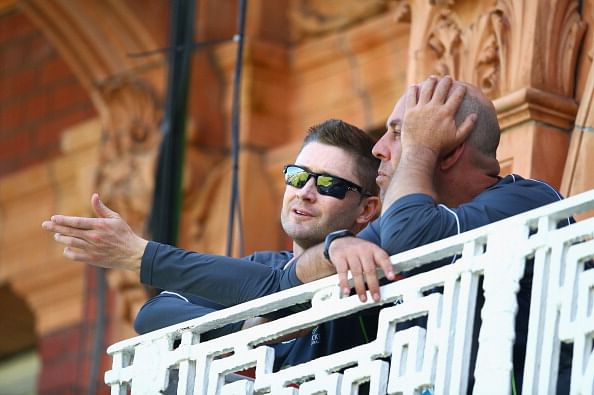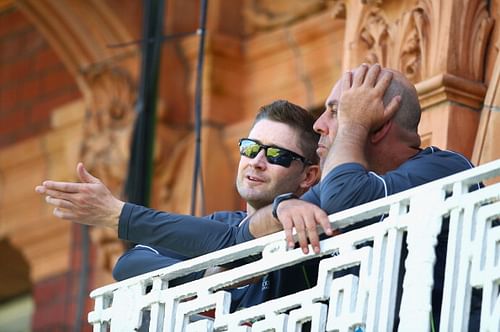
The Ashes 2013: Australia in the urgent need of batsmen

Michael Clarke and Darren Lehmann, coach of Australia, look on during day two of the second Ashes Test match against England at Lord’s Cricket Ground on July 19, 2013 in London, England. Australia were skittled out for just 128, losing their last six wickets for 42 runs. (Getty Images)
At the end of the Lord’s Test of the 2013 Ashes series, coach Darren Lehmann and captain Michael Clarke will have no need to search long and hard in order to discover the reason for their loss. The reason they will lose the second Test will be the same as the reason they lost the first; and it will be the same as the reason they will go on to lose this series.
If enough improvements are not engineered, it might well turn out to be the reason they also lose the Ashes series that follows in November. Their batting is inadequate to meet the demands placed on it by England’s highly adept and balanced bowling unit.
That the Aussies got close in the first Test, losing by only 14 runs, should not mislead anyone into thinking that the sides are not that far apart. The gulf between them is as wide as the ocean Australia had to traverse to get to England and their chances of bridging such a great divide is as feasible as it is of them making the journey by swimming.
While the visiting bowlers have fought hard to limit the English batsmen to reasonable totals, their willow-wielding colleagues have shown no inclination to impose such difficulties on England’s bowlers, whom they have allowed to knock them over with some ease.
The main exceptions were the two last-wicket partnerships in the first Test, which were counterproductive for Australian fans and pundits because it imbued their hearts with apparitions of Australian competitiveness.
Only very rarely will men batting at #11 get to within four runs of a century as Ashton Agar did, and last-wicket unions of 163 and 65, as happened in the first Test, are likely to be once-in-a-generation occurrences.
To offer prognostications favourable to Australia based on those happenings, as some fans and pundits have done, is to misinterpret the lessons of Trent Bridge, or, more likely, it shows that many fans are willing to dwell in fantasy land when expressing support for the home team.
Australia’s main hope for runs, coming into the series, had lain mostly with Clarke. But the fact that the captain – who has averaged over 60 since his elevation – has so far failed to hit his straps has left his team as if drifting in unknown waters without a compass.
And chances of them finding their way to firm ground – a solid platform of runs from which its bowlers can fashion victory are slim, as there just seems to be an absence of quality within the Australian’s batting ranks.
Shane Watson, for example, is their most seasoned opening batsman, but two hundreds in 42 Tests and an average of 35 tell the story of an underperforming Test player. His opening partner, Chris Rogers, has shown signs of adhesiveness, but it was mainly the dearth of top order players in Australia that prompted his recall, aged 35, to the Ashes squad after a single Test in 2008.
Ed Cowan looked so out of sorts in the first Test that he gave way to Usman Khawaja for the second. But the newcomer’s first series outing was far from auspicious, and he recklessly gave away his hand for 14 after having the good fortune of being dropped when on seven.
Phillip Hughes, Steven Smith and Brad Haddin have all played useful knocks so far, but Australia needs substantial scores, and so their batting has to perform as a unit, with batsmen forming alliances and building huge partnerships; otherwise, they will continue to be rolled over by their oldest rivals.
To be honest, England’s batting has not really gelled either. The problem for the Aussies, however, is that their task will be even more herculean if and when it does.
Australia needs better batting to give themselves a hint of a chance, but if the likes of Alastair Cook, Kevin Pietersen and Jonathan Trott return to anything like their normal insatiable run-gathering appetites, then even more distance will be created between the sides.
Ian Bell, who has compiled vital back-to-back hundreds at Trent Bridge and Lord’s, has been the only real bright spot in the host’s line-up. The evidence of his two recent big scores suggests he has finally twinned his silky stroke-play with a sturdier attitude. England has cause to rejoice.
This current tour ends on August 25, while the next Ashes series will begin in November 2013. Where will Australia find more capable Test batsmen?